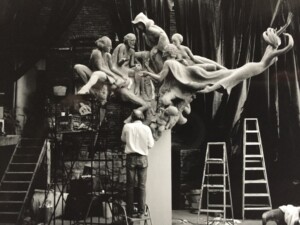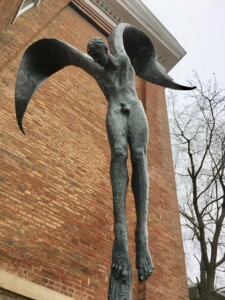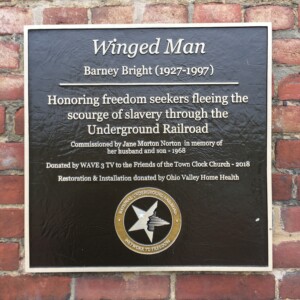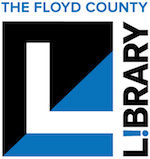Looking for a nice, art-filled walk in a safe, historic downtown setting? You know the fresh air and exercise will do you good! Three important Barney Bright bronzes are now in New Albany, all within easy walking distance of the Floyd County Library. While the streets may by temporarily quiet, the civic pride and community sense of place are present through its public art.
 Barney Bright is remembered on both sides of the Ohio River as an important and influential artist with a fifty-year career full of highlights. Bright loved working with the human figure in all its expressive glory. In order to produce the bronze art and commissions he hoped would follow, he created a foundry of his own that would later grow and become important regionally.
Barney Bright is remembered on both sides of the Ohio River as an important and influential artist with a fifty-year career full of highlights. Bright loved working with the human figure in all its expressive glory. In order to produce the bronze art and commissions he hoped would follow, he created a foundry of his own that would later grow and become important regionally.
Barney was a beloved mentor and employer, and many artists including the young Ed Hamilton, Paul Fields, David Lind, and Raymond Graf, found their own vocations through Bright’s Frankfort Avenue, Louisville studio. Bright passed away in 1997 and was honored with a posthumous retrospective at Louisville’s historic Water Tower. Barney Bright received the Arts Award for Lifetime Achievement by the Commonwealth of Kentucky in 1989.
 Our forty-minute walk begins in front of the Floyd County Library located at 180 W. Spring Street. Here you will find The Search, which Bright considered his masterpiece and could be the subject of a post on its own. It certainly is his largest and most ambitious bronze sculpture. The Search is thirteen feet long, eight feet high, and seven feet wide and weighs 3,000 pounds hollow! This allegory on the search for meaning in life features eleven figures, including a Bright self-portrait on top as an old man with a beard. Dedicated in 1985, the work was commissioned without taxpayer funds by the library board for the new library building and City of New Albany. Floyd County sculptor David Lind was a Bright assistant for the fabrication of this work.
Our forty-minute walk begins in front of the Floyd County Library located at 180 W. Spring Street. Here you will find The Search, which Bright considered his masterpiece and could be the subject of a post on its own. It certainly is his largest and most ambitious bronze sculpture. The Search is thirteen feet long, eight feet high, and seven feet wide and weighs 3,000 pounds hollow! This allegory on the search for meaning in life features eleven figures, including a Bright self-portrait on top as an old man with a beard. Dedicated in 1985, the work was commissioned without taxpayer funds by the library board for the new library building and City of New Albany. Floyd County sculptor David Lind was a Bright assistant for the fabrication of this work.
 Next stop is Bicentennial Park, 118 E. Spring Street, where Bright’s first important early commission can now be found. The slightly smaller than life-size bronze figure is entitled, Landscape. The work was commissioned for an indoor court garden with a water fountain by Louisville’s former Citizens Fidelity Bank in 1958. This is Bright’s first lost wax bronze and was cast for $1000 in New York. The style of this nude recalls earlier European figurative modernism as practiced by Bright’s teacher, Romuald Kraus. As you continue east on Spring, hang a right on Bank Street while waving to the Carnegie Center for Art and History, 201 E. Spring St., we look forward to serving you again in our historic building soon.
Next stop is Bicentennial Park, 118 E. Spring Street, where Bright’s first important early commission can now be found. The slightly smaller than life-size bronze figure is entitled, Landscape. The work was commissioned for an indoor court garden with a water fountain by Louisville’s former Citizens Fidelity Bank in 1958. This is Bright’s first lost wax bronze and was cast for $1000 in New York. The style of this nude recalls earlier European figurative modernism as practiced by Bright’s teacher, Romuald Kraus. As you continue east on Spring, hang a right on Bank Street while waving to the Carnegie Center for Art and History, 201 E. Spring St., we look forward to serving you again in our historic building soon.
Our walk ends two blocks south at 300 East Main Street and the address of the Town Clock Church, New Albany’s Underground Railroad site and home to the Second Baptist Church. A newly dedicated park behind the church memorializes the many who undertook great risks in the quest for freedom before enslavement in this country was ended. Barney’s Winged Man has been recontextualized and joins a new limestone sculpture of Lucy Higgs-Nichols and her child Mona carved by David Ruckman.

 Bright’s Winged Man has an interesting history and began life elsewhere. For nearly fifty years it stood in the WAVE 3 garden off Broadway Avenue in Louisville. After so many years the garden became overgrown and eventually this hidden sculptured was damaged. After repairs, this piece has been given a new lease on life. This sorrowful figure with its arms transforming into wings was commissioned by Bright’s first important patron, Mrs. Jane Morton Norton. In 1964, she lost both her husband and son in separate automobile accidents and had this work made to memorialize them. Barney was assisted by Paul Fields who would also craft a notable career of his own. Winged Man was completed in 1968.
Bright’s Winged Man has an interesting history and began life elsewhere. For nearly fifty years it stood in the WAVE 3 garden off Broadway Avenue in Louisville. After so many years the garden became overgrown and eventually this hidden sculptured was damaged. After repairs, this piece has been given a new lease on life. This sorrowful figure with its arms transforming into wings was commissioned by Bright’s first important patron, Mrs. Jane Morton Norton. In 1964, she lost both her husband and son in separate automobile accidents and had this work made to memorialize them. Barney was assisted by Paul Fields who would also craft a notable career of his own. Winged Man was completed in 1968.
Al Gorman, Coordinator of Public Programs and Engagement
Carnegie Center for Art and History, A Branch of the Floyd County Library


